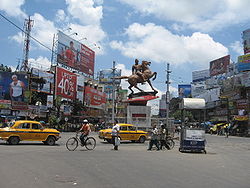Shyambazar
| Shyambazar | |
|---|---|
| Neighbourhood in Kolkata (Calcutta) | |

Shyambazar five: point crossing with statue of Netaji Subhas
|
|
 |
|
| Coordinates: 22°36′04″N 88°22′26″E / 22.601°N 88.374°ECoordinates: 22°36′04″N 88°22′26″E / 22.601°N 88.374°E | |
| Country |
|
| State | West Bengal |
| City | Kolkata |
| Ward | 11, 12 |
| Metro Station | Shyambazar |
| Parliamentary constituency | Kolkata Uttar |
| Assembly constituency | Shyampukur |
| Elevation | 36 ft (11 m) |
| Time zone | IST (UTC+5:30) |
| PIN | 700 004 |
| Area code(s) | +91 33 |
Shyambazar (Bengali: শ্যামবাজার) is a neighbourhood in north Kolkata, earlier known as Calcutta, in the Indian state of West Bengal. The area, under Shyampukur police station of Kolkata Police, has been, along with neighbouring Bagbazar, the citadel of the Bengali aristocracy, in a part of what was earlier known as Sutanuti.
Shyambazar broadly covers Ward Nos. 10, 11 and 12 of Kolkata Municipal Corporation.
The Japanese dropped a bomb near Hatibagan market during World War II but it did not explode.
There was a big market in the area, which Holwell called Charles Bazar. The present designation was conferred upon it by Sobharam Basak, in honour of Shyam Rai (or Gobinda), the attendant of the goddess Kali. The Basaks and the Setts were amongst the first to have settled in Sutanuti, after having cleared the jungles. Sobharam Basak was one of the wealthiest native inhabitants of 18th century Kolkata.
Growth and development of the neighbourhood and surrounding localities largely followed the construction of roads that opened up the area. Sutanuti had no roads, except the pilgrim path extending across it from Halisahar to Barisha. Chitpur Road (renamed Rabindra Sarani) was developed along this path. It passed through neighbouring Bagbazar and Chitpur. Road construction picked up in the early 19th century. The Lottery Commission (1817) and its successor the Lottery Committee (1836) opened up the native parts of old Kolkata. The main axial thrusts were from south to the north, parallel to the existing Chowringhee – Chitpur alignment.
...
Wikipedia
